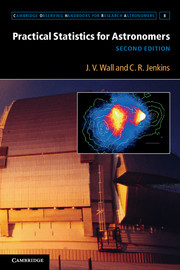Book contents
- Frontmatter
- Contents
- Dedication
- Foreword to first edition
- Foreword to second edition
- Note on notation
- 1 Decision
- 2 Probability
- 3 Statistics and expectations
- 4 Correlation and association
- 5 Hypothesis testing
- 6 Data modelling and parameter estimation: basics
- 7 Data modelling and parameter estimation: advanced topics
- 8 Detection and surveys
- 9 Sequential data – 1D statistics
- 10 Statistics of large-scale structure
- 11 Epilogue: statistics and our Universe
- Appendix A The literature
- Appendix B Statistical tables
- References
- Index
11 - Epilogue: statistics and our Universe
Published online by Cambridge University Press: 05 June 2012
- Frontmatter
- Contents
- Dedication
- Foreword to first edition
- Foreword to second edition
- Note on notation
- 1 Decision
- 2 Probability
- 3 Statistics and expectations
- 4 Correlation and association
- 5 Hypothesis testing
- 6 Data modelling and parameter estimation: basics
- 7 Data modelling and parameter estimation: advanced topics
- 8 Detection and surveys
- 9 Sequential data – 1D statistics
- 10 Statistics of large-scale structure
- 11 Epilogue: statistics and our Universe
- Appendix A The literature
- Appendix B Statistical tables
- References
- Index
Summary
Extraordinary claims demand extraordinary evidence.
(Anon)In the past it may have been true that Stephen Senn's (2003) analogy was right. Paraphrasing his words for the sake of moderate language: scientists regarded statistics as the one-night stand: the quick fix, avoiding long-term entanglement. This analogy is no longer apt. Statistical procedures now drive many if not most areas of current astrophysics and cosmology. In particular the currently understood nature of our Universe is a product of statistical analysis of large and combined data sets. Here we briefly describe the scene in three areas dominating definition of the current model of the Universe and its history. The three areas inextricably tie together the shape and content of the Universe and the formation of structure and galaxies, leading to life as we know it. While these sketches are not reviews, we show by cross-referencing how frequently our preceding discussions play in to current research in cosmology.
The galaxy universe
The story of galaxy formation since 1990 is based on two premises. Firstly, it was widely accepted that the matter content in the Universe is primarily cold and dark – CDM prevails. The recognition of dark matter was slow, despite Zwicky (1937) demonstrating its existence via the cosmic virial theorem. The measurements of rotation curves of spiral galaxies (e.g. Rubin et al., 1980) convinced us.
- Type
- Chapter
- Information
- Practical Statistics for Astronomers , pp. 291 - 315Publisher: Cambridge University PressPrint publication year: 2012

